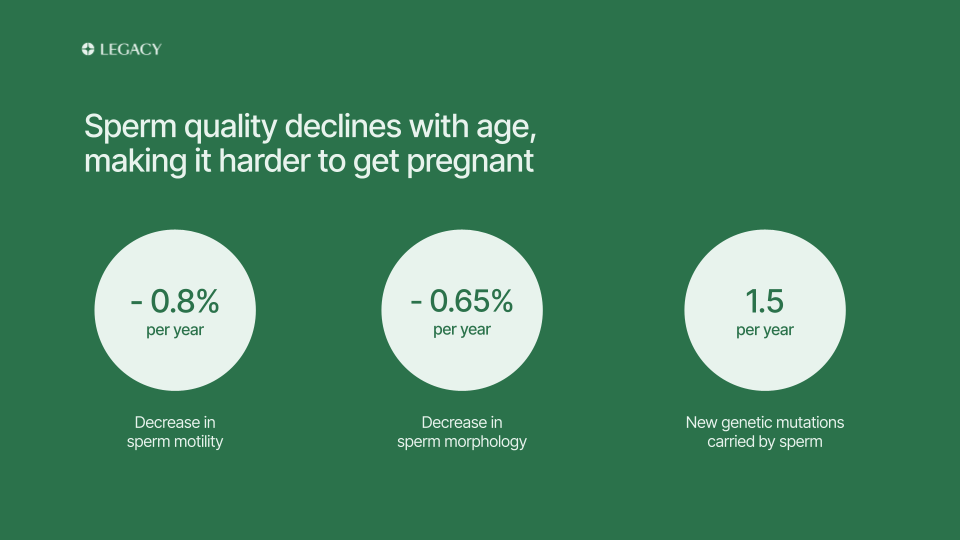When we hear the term “biological clock,” most of us tend to connect the term to women. After all, if the world’s oldest dad was able to father a baby at 96 years old, surely there’s no age limit on male fertility, right?
Not exactly. Stories of men in their 60s or older fathering children tend to fuel the idea that male fertility is eternal, but that’s a misconception. Men also experience the effects of aging with a decrease in fertility over time. To some extent, men—just like women—face a biological clock.
Key takeaways
- Male fertility typically begins to decline around age 35, becoming more pronounced after 40.
- Most men never completely stop producing sperm. But sperm quality deteriorates with age.
- Advanced paternal age increases risks for pregnancy outcomes and offspring health, including miscarriage, longer time to conception, and likelihood of certain health conditions in children.
- Lifestyle changes can help improve sperm quality, but freezing sperm is the most effective way to preserve fertility for the future.

When are men most fertile?
Most studies suggest that male fertility peaks between ages 30 and 35, although an exact age hasn’t been definitively identified. Male fertility decline typically begins at the age of 35 and gets steeper at 40.
The Centers for Disease Control and Prevention (CDC) reports that most men experience significant age-related fertility decline after they reach the age of 40.1 Other studies show that the decline begins around age 35—in one study, men over the age of 35 had fertility rates of 25%, compared to men under 35 who had fertility rates of 52%.2 Another study that evaluated the relationship between age and semen parameters also concluded that male fertility decline begins at 35, and suggested that male fertility peaks between 30 and 35.3
Bottom line: Men generally see a decline in fertility beginning at 35, and the downward trend progresses from there.
Do men stop producing sperm?
Generally, no. Women are born with all the eggs they’ll ever have, but men produce sperm throughout their lives (a process called spermatogenesis). However, although men typically never stop producing sperm, its quality measurably declines with age.

How does age affect male fertility?
Is there an “age limit” to male fertility? In a way. As a man ages, sperm count, motility, morphology, and genetic health can all be impacted. This can affect his ability to get a partner pregnant or have a healthy baby.
Sperm count and concentration
Sperm count is the number of sperm produced per ejaculation. A low sperm count can reduce the chance of pregnancy. One study found that sperm count declines up to 2.6% per year of age.4
Sperm motility (movement)
Sperm motility refers to how well sperm moves, or “swims.” Sperm with low motility have a lower probability of fertilizing an egg. According to research, sperm motility declines about 0.8% per year of age.5 When comparing the sperm in men between the ages 30 to 35 with men over 55, researchers found sperm motility was 54% lower in the older group.6
Sperm morphology (shape)
A sperm morphology test measures what percentage of sperm has the proper shape, size, and structure. Generally, men produce many abnormal sperm — morphology measurements as low as 4% are still considered within the normal range. But over time, that number tends to fall. Research has found that sperm morphology decreases by 0.2% to 0.9% per year of age.7
Sperm DNA fragmentation
Sperm DNA fragmentation index refers to the amount of abnormal genetic material (damaged DNA) inside sperm. Research indicates that sperm DNA fragmentation increases by 3% per year of age.8 DNA fragmentation can occur because of factors including oxidative stress, environmental toxins, and cellular aging.
Effects of advanced paternal age on pregnancy
Paternal age is among the most significant factors affecting a couple’s chance of conceiving and pregnancy outcomes. Men over the age of 35–40 typically experience a decrease in sperm health, which affects the following:
Pregnancy rates
Pregnancy rates decrease with paternal age. One study published in the journal Human Reproduction found that the likelihood of conception within 12 months was lower in older men, indicating decreased fertility in men aged 30 and above compared to those under 25.9 Men will generally see a 52% decrease in fertility rate between their early 30s and their mid-to-late 30s.10
Time to conception
Compared to men 25 years or younger, men 45 years or older are 12.5 times more likely to take over two years to conceive.11
Miscarriage risk
Pregnancy loss between the 6- and 20-week gestation period increases by 27% in fathers 35 years or older.12 That risk doubles when fathers reach 50.
Adverse pregnancy outcomes
Pregnancies that involve a male over the age of 45 see an increased risk of birthing complications, and their offspring have an increased risk for adverse birth outcomes.
Offspring health risks
Studies show that older fathers may be more likely to have children with conditions including:
- schizophrenia
- bipolar disorder
- autism
- Down syndrome
- childhood leukemia13 14 15
It is believed that random mutations in a man’s sperm accumulate over the years. This can pass genetic mutations to a child and increase their chances of developing a psychological or neurocognitive disorder or chronic illness.
How to improve male fertility with age
Aging is a natural process that can’t be halted or reversed, but lifestyle changes have been found to improve sperm health. These include:
- Eating a balanced, nutrient-rich diet
- Getting regular, moderate-intensity exercise
- Quitting smoking and vaping
- Getting adequate high-quality sleep (7 to 8 hours) nightly
- Drinking alcohol only in moderation
Sperm freezing for fertility preservation
Male fertility is not unlimited. Although men produce sperm for life, fertility typically declines starting at age 35, impacting sperm quality, pregnancy outcomes, and child health. Lifestyle changes can help, but freezing sperm is the most effective option for long-term fertility preservation.
Explore at-home sperm testing & freezing kits.
References
2. Centers for Disease Control & Prevention. “Infertility: Frequently Asked Questions,” 2024.
3. Stone et al. “Age thresholds for changes in semen parameters in men,” 2013.
4. Auger et al. “Decline in semen quality among fertile men in Paris during the past 20 years,” 1995.
5. Sloter et al. “Quantitative effects of male age on sperm motion,” 2006.
7. Harris et al. “Fertility and the Aging Male,” 2011.
8. Yatsenko et al. “Reproductive genetics and the aging male,” 2018.
13. Malaspina et al. “Paternal age and mental health of offspring,” 2016.
14. Fisch et al. “The influence of paternal age on down syndrome,” 2003.




